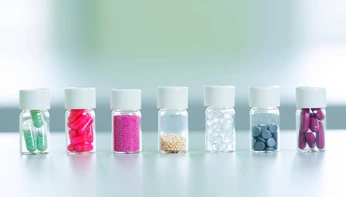
Formulation design is key to product success
Modern medicine continues to advance and become more personalized to meet the needs of an ageing global population. For pharmaceutical companies looking to bring a new oral drug product to market, selecting the right solid drug formulation can help to boost functional performance and accelerate speed to market.
This is why formulation design can make or break an oral drug product, and striking the right balance between functionality, performance and solubility is vital in its success.
With a broad range of applications, it is possible to coat almost everything with polymers, including crystals pellets, granules, and many types of tablets of different shapes and sizes. Determining the base shape of the product is a crucial first step in the process because the shape determines the required amount of coating material needed for taste masking, moisture protection, gastro resistance or sustained release and it has a great influence on the amount of polymer needed for the formulation.
Common excipients in coating formulations
Whether it be pellet or tablet formulation, it is vital to choose the right excipient based on permeability, design and functionality, depending on the need of the product. While it is better to make your formulation aqueous, there are certain dosage requirements that do not always run on time and can separate. Therefore, compromises need to be made to successfully formulate your coating design.
Coating formulations have different types of excipients – an auxiliary substance used in the formulation of a medicine – that bring about success in formulations. First, beside the drug itself there are necessary excipients, such as the polymer (which brings the functionality), with a plasticizer often then added to enhance fill flexibility, as well as an anti-tacking agent to avoid sticking. To maintain the right solid content in the spray suspension, solvents such as water can be added. In addition to the necessary excipients, there are optional excipients – such as pigments or glacing agents – as well as partially required excipients such as stabilizers or emulsifiers.
When considering coating formulation designs, the different formulation requirements that are important for dosage form and coating processes may not be fully met. For example, while plasticizers can be crucial for flexibility and fulfilled stability, it can provide an unwanted stickiness during the coating process. This is why adding an anti-tacking agent in this instance is important, although this might dull the visual appearance, which can then be enhanced with glossing agents or pigments.
The purpose of anti-tacking agents is to avoid sticking tendencies during the coating process and storage and they can be applied using agents such as talc, glycerol monostearate (GMS), PlasACRYL® T20 and PlasACRYL® HTP20, magnesium stearate or silica. The choice of anti-tacking agent will influence permeability, with silica providing the highest levels and GMS the lowest. This implies that not all anti-tacking agents are suitable for all desired functionalities like, for example, enteric protection.
Plasticizers can be used to improve film formation in aqueous coatings and increase film flexibility, prolonging the shelf-life of the tablet. This can be crucial for multiparticulate tablets as the manufacturer needs to be able to compress the coated multiparticulates into tablet and so requires a film flexible enough to withstand high levels of compression.
Using pigmentation, such as iron oxides, aluminum lakes, mica pigments, dyes and natural colorants in formulation design is another option available. EUDRAGIT® polymers have a high binding capacity and can provide the basis for more advanced tasks such as drug-layering. When pigments are used they can lower the film flexibility as an increased amount of plasticizer is required in the formulation. Furthermore, they can interact with other excipients and consequently affect tablet functionality. This obstacle can be overcome with a “double layer” coating, which has no pigments in the inner functional layer and instead has a heavily pigmented outer layer.
The role of excipients in the coating formulation is vital to maintain the functionality of polymer film. Manufacturers therefore need to make sure that the selected polymers and additional excipients provide the proper functionality to the API and deliver the tablet to the desired place of action.
Advanced formulation design
If a manufacturer is looking to explore more sophisticated formulation designs to meet more challenging release profiles, there are several options available under the Evonik portfolio. For example, EUDRATEC® technologies work in different pH ranges and provides a safety net when it comes to colonic delivery.
Advanced formulation does not have to be complicated – EUDRACAP®, which are pre-locked, empty coated capsules, are suitable for the filling of drug forms such as powders, pellets and granules. The versatility of the capsules means they can meet specific release profile requirements, with effective acid resistance for up to four hours.
Conclusion
When designing an oral drug delivery product, it is crucial to formulate successfully with the right balance of polymers and other excipients to create a functional product for use. The EUDRAGIT® polymer portfolio offers a wide variety of applications, including taste and odor masking, moisture and light protection, swallowability improvement, GI-targeting and extended release. This makes them the ideal functional excipients for oral delivery of drug products with immediate, delayed, controlled or many other complex release profiles.



